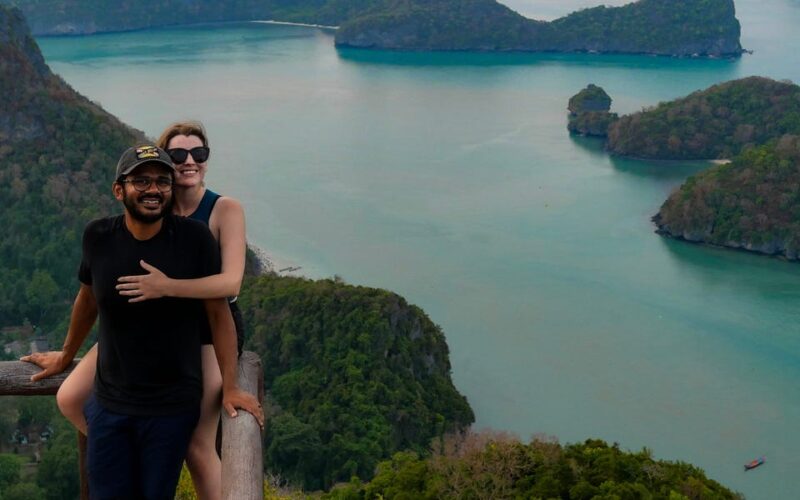A week into their honeymoon in 2022, Katie Flynn and Mistry Bhavik faced a major healthcare: Flynn had caught a severe amoeba infection while traveling in the Philippines. The monthlong vacation they had been dreaming about had to be cut short.
Both full-time pharmacists in Ontario, Canada, the couple had no idea when they could travel for a long period again. Although Flynn had three weeks of vacation days, Mistry would have had to take unpaid leave as a contract pharmacist.
At the same time, they were feeling burned out by their healthcare jobs. The COVID-19 pandemic had taken a toll on their mental health, and it was getting harder to give their best at work.
“I was noticing that I didn’t have that same degree of patience and compassion, and I was not being the best version of myself,” Mistry said. “I knew I needed a hard reset.”
So they made a plan: Save as much as possible for a year and a half, then leave on a one-way ticket.
Friends and family were hesitant about the gap year
“My family was initially surprised that I wanted to ‘throw away’ the things I’ve been working toward,” Mistry said.
Many people also asked Flynn and Mistry, both in their early 30s, questions about having children. They responded with frustration: “Sometimes, it kind of feels like it’s the only thing that people want to talk to us about at our age,” Flynn said.
Moreover, taking a gap year is less common among people in their age group, Mistry said.
Most of their peers had gone on long-term trips after graduation. But Flynn and Mistry had pursued advanced degrees and graduated in their mid-20s with significant student debt.
So, after working for a few years and establishing themselves professionally, they decided it was the right time to leave.
Their first step was to set a realistic budget
Katie Flynn and Bhavik Mistry
Flynn and Mistry turned to other travel bloggers and sites like Budget Your Trip to decide on their budget. However, they got a mix of responses. Some had spent generously to travel in luxury while others kept to small budgets.
“We had to be realistic about what our travel style is. We don’t want to camp for 365 days,” Flynn said.
The couple set a budget of $45,000 — or $123 per day for both — for their yearlong trip. This daily budget is less than what they spend in Ontario, which they estimate is around $220 per day.
Alternate income streams to fund their travel
On top of their full-time jobs, they rented out their basement for $868 a month. Additionally, they sold 95% of their belongings on Facebook Marketplace — including their furniture, electronics, and clothes, and say they made around $7,200.
They also participated in paid focus groups, which amounted to around $360.
Planning as they go along
After a year and a half of saving, the couple finally set off to Japan in May. However, apart from booking hotel rooms in advance, the couple did not plan an itinerary.
“Our goal was to have a year of freedom. So we didn’t want to overplan away the freedom,” Flynn said.
The next stop was Thailand, and their original plan had been to fly to Malaysia next. However, after spotting affordable flights to Sri Lanka, they spontaneously decided to book tickets there instead.
“It’s nice to be able to figure it out like that,” said Flynn, who added that planning less often leads them off the beaten path.
Katie Flynn and Bhavik Mistry
Two months into their adventure, they regularly update their Instagram page, @katieandbhav, where they have also found a community of like-minded travelers.
For burned-out millennials, long-term travel offers respite
Flynn and Mistry are not alone in their burnout, which the World Health Organization defines as a syndrome caused by chronic workplace stress.
According to a 2024 Work in America Survey conducted between March and April by the American Psychological Association among over 2,000 adults, 67% of workers reported experiencing at least one outcome associated with burnout.
Some millennials, like Flynn and Mistry, have turned to long-term travel to escape corporate life.
Olivia Young, a millennial who used to work in public relations, previously wrote for Business Insider that she quit her job to travel after facing burnout. She flew to New Zealand on a working holiday visa and said the experience gave her the freedom to live a life she’s passionate about.
For Jo Fitzsimons, who left her job as a lawyer in 2010, her plan to travel during her career break became a full-time commitment. Now, she is a travel blogger who has traveled to over 50 countries, she told BI.
As for Flynn and Mistry, life after their gap year remains uncertain.
“We both do love our jobs. We like being pharmacists,” Mistry said.
Flynn is unsure what will happen at the end of the year. “We’re just trying to be in the moment right now and not overthink it.”
Source link
lol

